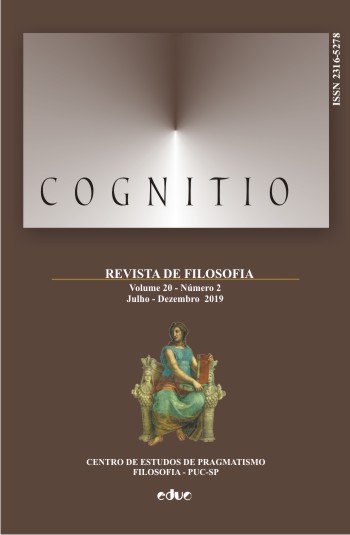“O segredo geral de tornar os signos efetivos:” sobre as raízes aristotélicas do conceito de retórica de Peirce como dynamis, téchne e forma semiótica do summum bonum
DOI:
https://doi.org/10.23925/2316-5278.2019v20i2p404-428Palavras-chave:
Aristóteles, Comunicação, Enteléquia, Retórica ordinária, Semeiose, Retórica especulativa, Summum Bonum, Arte universal de retórica.Resumo
Neste e no próximo artigo, buscamos articular a visão compreensiva arquitetônica de Peirce a respeito do fenômeno da retórica relacionando sua abordagem em Ideas, Stray or Stolen, about Scientific Writing (MS 774, 1904) com seu tratamento na classificação muito negligenciado das ciências práticas (MS 1343, 1903). Neste artigo, primeiro, reconstruímos o principal eixo conceitual de Ideas, Stray or Stolen, que é erguido pelos termos ‘arte universal da retórica’, ‘retórica ordinária’, e ‘retórica especulativa’. Na medida em que este eixo nos guia para a classificação dos estudos especiais da retórica que Peirce propõe na seção final de Ideas, Stray or Stolen, a cuidadosa reconstrução deste eixo constitui um dever hermenêutico, a negligência do qual impediria uma compreensão adequada do que Peirce está classificando no fim de sua abordagem mais madura da Retórica Especulativa (Seção I). Em seguida, procedemos à exposição das raízes aristotélicas da concepção de Peirce da arte universal da retórica (Seção II) e analisamos a relação intrínseca que a semiose retórica tem com o summum bonum como uma de suas formas evolutivas históricas (Seção III). Se esta interpretação da concepção de retórica do Peirce é adequado, no entanto, devemos esperar que ele nos dê em algum lugar uma descrição da capacidade de evolução da retórica – e portanto, de crescer – antes de tudo. Será a tarefa de um segundo artigo subsequente mostrar que e de que maneira a concepção de Peirce da a retórica como ciência prática (τέχνη) e faculdade instintiva (δύναμις) enraizado no “instinto gráfico” (MS 1343) responde pela sua capacidade para o crescimento.Downloads
Publicado
2020-02-16
Como Citar
Topa, A. (2020). “O segredo geral de tornar os signos efetivos:” sobre as raízes aristotélicas do conceito de retórica de Peirce como dynamis, téchne e forma semiótica do summum bonum. Cognitio: Revista De Filosofia, 20(2), 404–428. https://doi.org/10.23925/2316-5278.2019v20i2p404-428
Edição
Seção
Artigos Cognitio









